#QZ8501 live report: Rescuers start retrieving bodies, debris from water; '95%' likely from plane
Yahoo Newsroom – 15 minutes ago
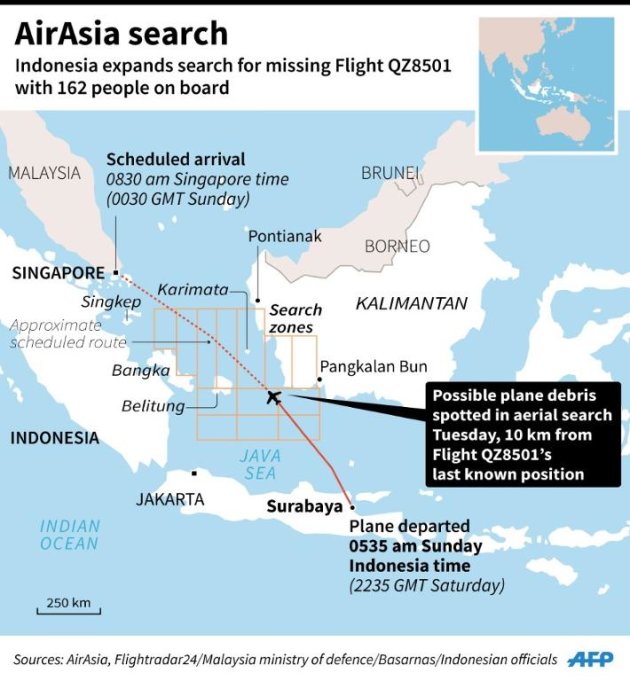 Updated map showing the search zones for the missing AirAsia Flight QZ8501 (click for larger version)
Updated map showing the search zones for the missing AirAsia Flight QZ8501 (click for larger version)
REPORTING FROM SINGAPORE [All times indicated are in GMT+8, unless otherwise specified]
WHAT WE KNOW SO FAR:
- Indonesia air traffic control (ATC) lost contact with AirAsia flight QZ8501 bound for Singapore from Surabaya, Indonesia and carrying 162 people on board went missing on Sunday morning, around an hour after it left Juanda International Airport at 5:35am Indonesia time.
- Indonesian rescue personnel are descending into the water to retrieve bodies and debris found in the area, about 10km away from where the plane was last seen on the radar. The navy has said via AFP that it has picked up more than 40 bodies from the area so far.
- Indonesia's search and rescue chief says he is "95 per cent sure" that the debris found so far belong to the missing aircraft. Next-of-kin of the passengers and crew have also been informed to this effect.
- The plane was over the Java Sea between Belitung island and Pontianak, on Indonesia's part of Kalimantan island, tracked four minutes after its pilot, Captain Iriyanto, stopped responding to ATC. Iriyanto had requested at 6:12am Indonesia time to veer left (this was approved) and ascend to 38,000 feet from 32,000 feet. After Indonesia's ATC informed the pilot at 6:14am Indonesia time of a revised height of 34,000 feet (because flight QZ8502 was cruising at 38,000 feet altitude), there was no response. The plane was then officially declared missing at 7:55am Indonesia time.
We've put together the stories of some of the passengers and crew on board the plane as well. Click here to read it.
LATEST UPDATES:
Tuesday, 30 December
6:12pm: Singapore defence minister Ng Eng Hen said in a Facebook post that Singapore's ships deployed in the search area have been directed to the area where bodies and debris were found. The MV Swift Rescue, a submarine support and rescue vessel, will set sail this evening to join the ongoing rescue and retrieval operation, he added.
"The SAF will do all it can to assist Indonesia in this very difficult time. We offer our deepest sympathies to families of the passengers and crew," he said.
6:03pm: Relatives of the passengers and crew on the missing plane were seen breaking down at the news of the debris and bodies being found near where QZ8501 was last seen on the radar.
Some were stretchered out of the holding room as well:
 Government security officials carry a family member of passengers onboard AirAsia flight QZ8501 after she collapsed …
Government security officials carry a family member of passengers onboard AirAsia flight QZ8501 after she collapsed … The hand of family member of passengers onboard AirAsia flight QZ8501 is pictured at a waiting area in Juanda International …
The hand of family member of passengers onboard AirAsia flight QZ8501 is pictured at a waiting area in Juanda International …
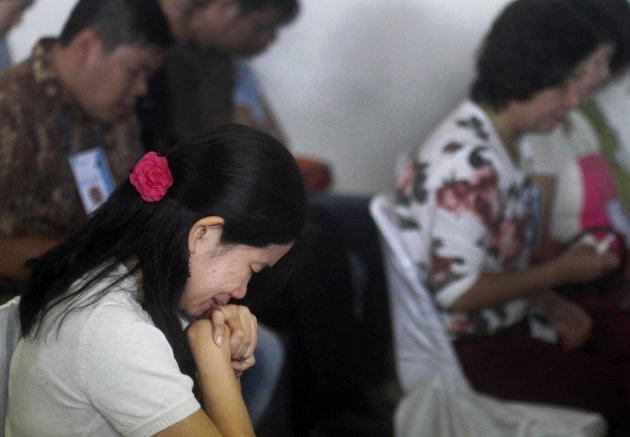 A relative of passengers of the missing AirAsia flight QZ8501 weeps as she prays at the crisis center at Juanda …
A relative of passengers of the missing AirAsia flight QZ8501 weeps as she prays at the crisis center at Juanda … 5:31pm: The Indonesian Navy says it has retrieved more than 40 bodies from the water so far,reports AFP in a news alert.
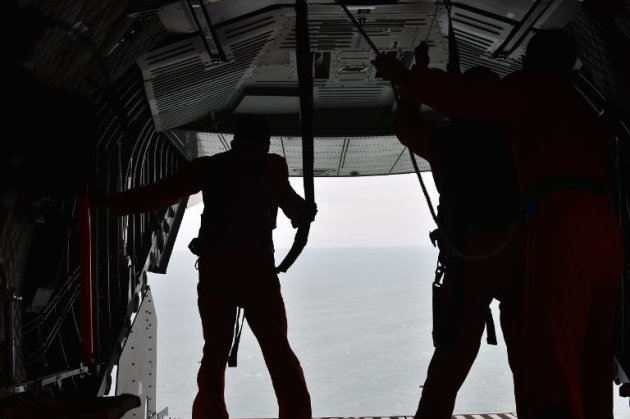 Indonesian Air Force crew members take part in the search and rescue operation for AirAsia Flight QZ8501 over waters …
Indonesian Air Force crew members take part in the search and rescue operation for AirAsia Flight QZ8501 over waters …4:48pm: Yahoo Singapore has been informed by a relative of the next-of-kin of a passenger on board the missing plane that the debris found is confirmed to be from QZ8501. They have also been told to prepare for the worst.
4:38pm: Indonesian channel TVOne has started broadcasting images of divers descending from helicopters into the water to retrieve bodies and other items that have so far been found in the area:
 A screengrab from Indonesian channel TV One shows a diver descending into the water to retrieve bodies and other …
A screengrab from Indonesian channel TV One shows a diver descending into the water to retrieve bodies and other …4:29pm: The Associated Press reports that bodies were found floating near the site where the missing plane was last seen.
Meanwhile, an air force plane spotted a "shadow" on the seabed, believed to be the missing jet.
3:59pm: Indonesia search and rescue chief Henry Bambang Soelistyo says he is "95 per cent sure" that the debris found so far by search and rescue teams is from the missing AirAsia flight, announcing this in a press conference broadcasted live minutes earlier.
"The remaining 5% (doubt) is because I have yet to see for myself the emergency door and other debris," he added. The debris, he said, were found 10km away from the spot where the plane was last seen on the radar.
He said that all debris found will be brought to the search base in Belitung, and has mobilised all resources searching the water to move toward the area where the items, and at least one body, were spotted.
He also said a boat with 11 divers from the Indonesian navy and the Indonesian search and rescue team has been sent to the exact location so they can pick up as much evidence as possible to examine.
3:28pm: The Jakarta Post quotes Indonesian aviation chief Djoko Murjatmodjo as saying thatdebris found by the Indonesian search and rescue team so far is confirmed to be "from an aircraft bearing red and white colours".
“The recovery process will now be centered in the debris location in coordination with Basarnas [the National Search and Rescue Agency],” he reportedly said.
2:25pm: Two images from AFP of the alleged plane debris spotted in the water:
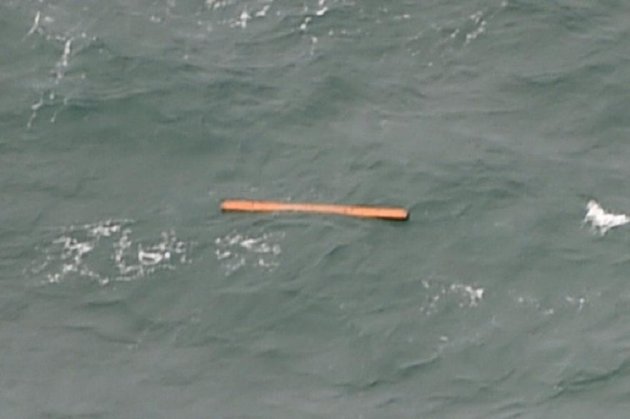 One of the pieces of alleged plane debris spotted floating in the water. (AFP photo)
One of the pieces of alleged plane debris spotted floating in the water. (AFP photo)
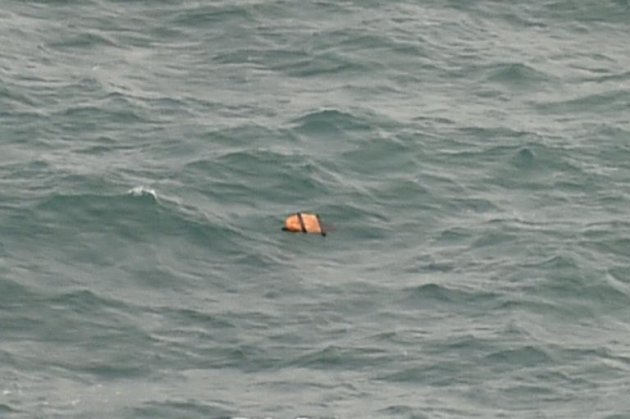 This aerial view taken from an Indonesian search and rescue aircraft over the Java Sea shows floating debris spotted …
This aerial view taken from an Indonesian search and rescue aircraft over the Java Sea shows floating debris spotted …
1:58pm: Indonesian TV networks Metro TV and Kompas TV are broadcasting images of items they are alleging to resemble a plane door and an emergency slide, found in the water:
 Screengrab of Kompas TV live stream shows an image of one of the pieces of alleged debris spotted in the water. …
Screengrab of Kompas TV live stream shows an image of one of the pieces of alleged debris spotted in the water. …1:50pm: AFP reports that objects resembling an emergency slide and a plane door were seen in the search, attributing it to Indonesian air force official Agus Dwi Putranto.
"We spotted about 10 big objects and many more small white-coloured objects which we could not photograph," he reportedly told a press conference, adding that they were found about 10km from the spot where the plane was last seen on the radar.
1:06pm: New Zealand has joined the international search for the missing plane, and has dispatched a P3 Orion to Darwin where it will await instruction from search authorities. Australia has in the meantime sent off another P3 Orion aircraft loaded with specialist search equipment toward the perimeter.
12:41pm: The Telegraph's Tom Phillips says in a series of tweets that relatives of the missing passengers and crew on board QZ8501 will on Wednesday be flown to Belitung island on a dedicated A320 jet from Surabaya's Juanda airport to be closer to the search operations.
Various news media say there are 180 available seats on the plane, which will circle the search area to allow families to pray for their missing relatives. Leftover seats, according to The Straits Times, will be given to media.
12:00pm: Channel NewsAsia reports that there are now seven local boats and seven international craft scouring the prime search spot in the waters off Belitung.
Meanwhile, Indonesia's search and rescue agency (BASARNAS) reportedly says two emergency signals it received were not from the missing plane.
11:44am: Indonesian pilot federation advisor Manotar Napitupulu has criticised Indonesian air traffic controllers, saying they should be more proactive in guiding pilots on their routes, CNN Indonesia reports.
He reportedly said ATCs from other countries routinely inform pilots ahead of time about obstacles in their path, such as poor weather, and guiding them in alternate directions. Manotar said, however, that Indonesian ATCs have improved in recent years.
11:17am: The Wall Street Journal reports that AirAsia had commenced the upgrading of its short-haul jets to incorporate a dedicated tracking service, but did not upgrade the plane that went missingon Sunday morning.
The report quotes Inmarsat's vice president of external affairs Chris McLaughlin, who said that the budget carrier had started deploying satellite communications on some of its A320s that would provide position updates every two minutes, but the QZ8501 plane was not yet modified.
10:56am: AFP reports via the South China Morning Post that the two oil slicks initially spotted by an Indonesian helicopter on Monday are actually coral reefs. The report cited Indonesia's national search and rescue chief Henry Bambang Soelistyo for this detail.
10:02am: South Korea's Yonhap news agency reports that the country's defence ministry has said itwill send a navy P-3C surveillance plane, also previously deployed in the search for the still-missing MH370 plane, to join the search later today.
"As soon as the necessary process (of coordinating air space crossing) is completed, the patrol aircraft could be sent to Indonesia Tuesday night," it said.
9:42am: Here's a map of the newly-expanded search area that now spans 13 sectors, courtesy of Wall Street Journal reporter Jon Ostrower:
Here's the just-released official SAR map for the Java Sea for day three of the search for #QZ8051
8:40am: Two small planes have according to CNN and CBS been sent to an island within the search area where a fire was reportedly detected.
Also, Channel NewsAsia reports that China is sending a naval ship and an air force plane to assist in search operations. The frigate will head to the search zone from where it is patrolling in the South China Sea, while the air force jet is coordinating a flight route over.
7:49am: Plane's last communication with Indonesian air traffic control revealed
State navigation operator AirNav Indonesia overnight revealed the details of the last messages sent between flight QZ8501 and Indonesian air traffic control, saying that the pilot on board had not explained why he wanted to ascend to 38,000 feet.
After giving immediate approval at 6:12am Indonesia time to veer left, which the plane then did, Indonesian air traffic control could not permit the jet to rise to that altitude as AirAsia flight QZ8502 was cruising at that level. The Jakarta Post reports that Indonesian air traffic control then coordinated with its counterpart in Singapore to determine an approved 34,000 feet altitude. When they had informed the pilot of the approved height to ascend to at 6:14am, however, they did not receive any response.
It was then at 7:55am Indonesia time that the plane was officially declared missing.
Malaysian chief of navy Abdul Aziz Jaafar also tweeted a revision in allocated sectors for today's surface search:
#QZ 8501: Revised Sectors for the conduct of surface search effective 30 Dec 14. RMN allocated Sectors 1 & 2.
Rappler reports that the Philippine Navy and Air Force is also ready to send support to the search for the missing plane. A statement from the Philippine army reportedly said two C130s, two Fokker planes, one Islander and a PF-16 navy vessel are on standby for deployment.
7:25am:
 The guided missile destroyer USS Sampson. (Screengrab: Channel 8 San Diego)
The guided missile destroyer USS Sampson. (Screengrab: Channel 8 San Diego)
NBC, CNN International, CNBC and an ABC News reporter are quoting a senior US military official as saying that America is sending over an Arleigh Burke-class destroyer to assist in search operations. The USS Sampson is a guided missile destroyer that has superior radar technology designed to disperse enemy surveillance, alongside rockets, missiles and an anti-submarine helicopter. 7:17am: Indonesia has requested assistance from the US in its search for the missing plane, which re-commences this morning.
"We are reviewing that request to find out how best we can meet Indonesia's request for assistance," said a statement from the US embassy in Jakarta. American officials have not yet said what kind of aid might be provided.
Meanwhile, overnight, Indonesian president Joko Widodo addressed a news conference, saying he has instructed his transport ministry to review their aviation procedures immediately while asking met agency officials to provide comprehensive weather forecasts to enhance airline safety.
The story from day 2:
As night fell, the second day of an ongoing international search operation produced scant evidence of the missing AirAsia flight QZ8501, which departed for Singapore from Surabaya's Juanda International Airport on Sunday morning and dropped off the radar after about an hour of flight.
Aerial operations were suspended by about 6:45pm Indonesia time, while some 30 ships from Indonesia, Singapore and Malaysia continued scouring the Java sea in the northern and eastern parts of Belitung island past dusk. Another Singapore naval vessel, a landing ship tank, on Monday evening set sail for the area to join the search as well. A Singaporean submarine support and rescue vessel has been given the green light for dispatch by Indonesian authorities too.
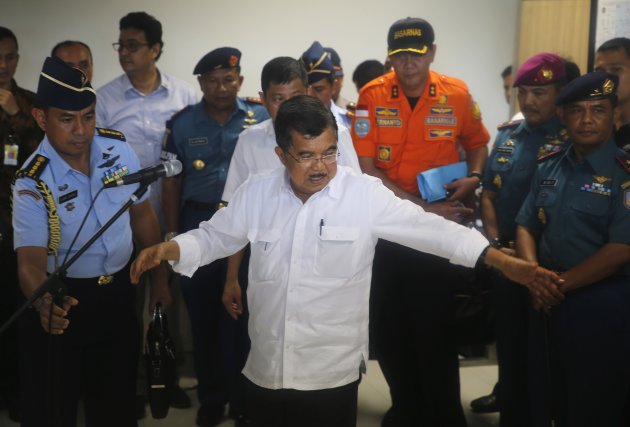 Indonesia's Vice President Jusuf Kalla gestures before deliver a speech in front of family members of passengers …
Indonesia's Vice President Jusuf Kalla gestures before deliver a speech in front of family members of passengers …Indonesian vice president Jusuf Kalla said in a press conference on Monday that a total of 15 aircraft, including helicopters, from the three countries as well as Australia, and 30 ships are involved in the hunt, which has thus far shown little result.
An object spotted by the Australian AP-3C Orion search plane on Monday turned out to be unrelatedto the jet, while Indonesian officials are still investigating the source of two oil slicks spotted in the search area — the spot where the oil was found lay on a shipping line, they said.
Subsequent reports then noted Indonesia's plans to expand the hunt to the western part of Kalimantan, on land, among other areas, despite the search and rescue agency chief Bambang Soelistyo voicing his belief that radar data analysis showed the plane was likely to be at the bottom of the sea.
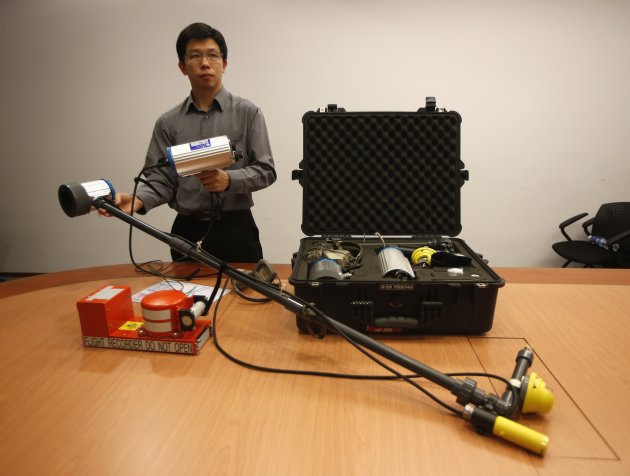 A specialist from Singapore's Ministry of Transport's Air Accident Investigation Bureau (AAIB) showcases …
A specialist from Singapore's Ministry of Transport's Air Accident Investigation Bureau (AAIB) showcases …The country's search and rescue agency has also accepted Singapore's offer to send two specialist teams with two underwater locator beacon detectors to the sea search area. Singapore's Maritime and Port Authority has additionally offered to send a side-scan sonar system and a robotic remotely-operated vehicle to assist the teams.
More offers of support have flowed in from countries like Britain, Japan, South Korea, China, the UK, the US, France and reportedly Russia, to back up the ongoing search effort.
On board the missing AirAsia plane are a total of 162 people — 138 adults, 16 children and one infant, making up 155 passengers along with seven crew members (two pilots, four flight attendants and one engineer).
The passengers comprise one Singaporean, one Malaysian, one British, three South Koreans and 149 Indonesians, while the crew consists of six Indonesians and one French (the co-pilot). See the full manifest here, and read more about their stories here.
 Next-of-kin being given an update on AirAsia QZ8501 by Mr Logan Velaitham, CEO of AirAsia Singapore, at Changi …
Next-of-kin being given an update on AirAsia QZ8501 by Mr Logan Velaitham, CEO of AirAsia Singapore, at Changi …Distressed relatives gathered on Sunday and Monday at Singapore's Changi Airport and Surabaya's Juanda International Airport, where airline and government officials met with them in various closed-door sessions. AirAsia Indonesia CEO Sunu Widyatmoko and AirAsia CEO Tony Fernandes are both stationed in Surabaya to be with the families.
Singapore's Civil Aviation Authority said a total of 27 registered passenger next-of-kin had taken up an offer to fly to Surabaya to join hundreds of other relatives waiting for updates there.
Search and rescue workers prepare to load body bags onto a flight to Kalimantan in Pangkal Pinang, Bangka December 30, 2014. Indonesian rescuers saw bodies and luggage off the coast of Borneo island ...
more
QZ8501 lost contact with Indonesian air traffic control at 7:24am Singapore time on Sunday, 42 minutes after departure and an hour before it was scheduled to land in Singapore.
Reuters reports that the aircraft was between the Indonesian port of Tanjung Pandan and the town of Pontianak, in West Kalimantan on Borneo island, when it went missing without a distress signal.
The plane stayed on its submitted flight plan route before it asked for permission to deviate to avoid "bad weather" described by officials as dense storm clouds, strong winds and lightning.
"The plane requested to the air traffic control to fly to the left side which was approved, but their request to fly to 38,000 feet level from 32,000 feet could not be approved at that time due to a traffic, there was a flight above, and five minutes later the flight disappeared from radar," said an Indonesian air transport official.
The pilot in command, Captain Iriyanto, had a substantial total of 6,100 flying hours and the first officer, Remi Emmanual Plesel, a total of 2,275 flying hours, said AirAsia, adding that the jet underwent its last scheduled maintenance on 16 November this year.Air Asia chief Tony Fernandes confirmed the plane had been given the all-clear by aviation technicians, was in "good condition" and "has never had any problems whatsoever".
According to Airbus, the missing A320-200 is a twin-engine single-aisle aircraft seating up to 180 passengers in a single-class configuration.
It was registered as PK-AXC and was delivered to AirAsia from the production line in October 2008. Powered by CFM 56-5B engines, it had accumulated approximately 23,000 flight hours in some 13,600 flights.
Airbus said it would provide full assistance to authorities in charge of the investigation.
Indonesian transport minister Ignasius Jonan said on Monday that the local government will review AirAsia's Indonesian operations in light of the ongoing disappearance.
Meanwhile, AirAsia's stock tumbled on Monday as the markets opened, reflecting shaky investor confidence off the back of the missing flight. It recovered slightly but still closed more than 8 per cent down at the bell.
Essential information
AirAsia has established an Emergency Call Centre that is available for family or friends of those who may have been on board the aircraft. The number is +62 212 927 0811 or 031- 869 0855 or 031- 298 6790 (Surabaya).
Relatives of passengers are asked to call the following dedicated hotlines:
Malaysia: +60 321 795 959
Indonesia: +62 212 927 0811
Singapore: +65 6307 7688
Korea: 007 9814 206 9940
AirAsia will release further information as soon as it becomes available. Updated information will also be posted on the AirAsia website at www.airasia.com.
(Correction: This article initially identified the aircraft as an A380. It is an A320.)